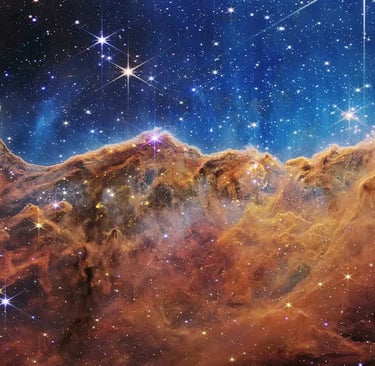The Cosmic Cliffs: A New Discovery by NASA's James Webb Telescope


Introduction to the Cosmic Cliffs
The James Webb Telescope has once again proven its remarkable capabilities by unveiling a mesmerizing celestial landscape, aptly nicknamed the "Cosmic Cliffs". This ethereal formation, located within the nebula Gum 31, presents a stunning visual spectacle that has fascinated astronomers and the public alike. With its misty appearance and the surreal steam rising from celestial mountains, the Cosmic Cliffs not only capture our imagination but also provide invaluable insights into the life cycles of stars.
Formation and Characteristics of the Cosmic Cliffs
At the heart of these cosmic formations are the stellar winds and ultraviolet light emitted by the stars in NGC 3324. As these intense forces interact with the surrounding material, they carve a cavernous area in the nebula, leading to the development of the Cosmic Cliffs. This carving action is essential for understanding how stars influence their environments, creating regions where hot, ionized gas and dust escape from the nebula. This outflow, often referred to as stellar wind, represents a dynamic process essential for star formation and the evolution of galaxies.
The Visual Majesty: Gas and Dust Dynamics
The Cosmic Cliffs' breathtaking appearance is enhanced by bright yellow streaks and arcs that signify outflows from the young, forming stars nestled within these cliffs. The interplay between the young stars and the surrounding gas is a critical factor in the ongoing evolution of this majestic nebula. As ultraviolet radiation bombards the area, hot gas and dust streams away from the Cosmic Cliffs, creating a mesmerizing spectacle that exhibits the raw power and beauty of the universe.
Through precise imaging and data processing, the James Webb Telescope has opened a door to observing such phenomena in unprecedented detail. This innovative technology allows scientists to capture not only the visual splendor of the Cosmic Cliffs but also to delve deeper into the mechanics at play in nebulae like Gum 31.
As we continue to study the Cosmic Cliffs, the James Webb Telescope stands at the forefront of astronomical exploration, promising new discoveries that will enhance our understanding of the universe. These findings will undoubtedly ignite further interest in cosmic phenomena and inspire generations of scientists and stargazers.
